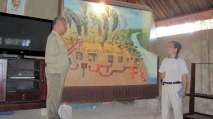 The Cu Chi tunnel complex, an underground web of impossibly-small, cramped and very-well-hidden tunnels and villages, is one of many testaments to the ingenuity of the Vietnamese people, who had been the victims of invading warriors for many hundreds of years, up until the end of the Vietnam-America war in 1975. Digging began in 1948 for the guerrillas to hide from French air and ground sweeps, and continued through the 50s and 60s during the American invasion. Using tiny hand tools to continuously scrape away dirt, and small woven buckets to carry the dirt out, the tunnels were used for communication routes, food and weapons caches, hospitals and living quarters for guerrilla fighters. In the video, you'll see a former Vietnamese veteran who lived in the tunnels during the war. You'll notice he is missing one arm -- which he lost in the war. He also lost an eye in the war. As part of his overview of the tunnel phenomenon, he explained what it was like to live in these subterraneous hamlets where lack of air, food and water made life nearly unbearable. At the end of his presentation, speaking as a veteran and on behalf of a people who have been near-continuously invaded by outsiders for hundreds of years, this gentleman poignantly emphasized the desire of the Vietnamese people for no more war, and a deep hope for peace among mankind. As we walked the grounds we saw examples of the weapons and deadly booby traps of all kinds that were used by the Vietnamese. We also had the chance to climb down into the tunnels. The video shows our endurance athlete, Sara Miller -- despite the extreme heat and humidity -- trying to enter a tunnel via a well-hidden trap door she'd discovered a few minutes before.
0 Comments
I apologize for the disorder of these videos. A lack of consistent high speed internet connection has hampered my ability to upload videos, often resulting in aborted attempts for some videos during the upload process which then places videos out of chronological order. This post includes additional videos of Governor Kernan and Maggie's visit to the shoot-down site last Friday, including the excitement and confusion of the initial meeting and review of photos and other documents just prior to the motorcade trip to the village. 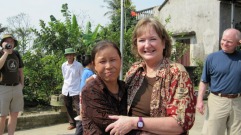 Our visit to Vietnam ended yesterday when we flew from Saigon/HoChiMinh City to Siem Reap, Cambodia -- where we've gone from 'hot' to 'much hotter' (and steamier!) weather. Our internet connection is even more spotty here but, if I'm lucky, you'll be reading this soon. In these exclusive videos, the raw and unedited footage will give you a good sense of the emotion and drama of our momentous visit to Governor Kernan's 'shoot-down' site last Friday. However, the professional journalists of WSBT and WNDU pull it all together for you with their wonderful writing and editing, and I urge you to check out their stories. The videos are posted in chronological order, beginning with the motorcade into the village. You'll see a particularly moving moment in one of the videos where a Vietnamese man who helped save Joe Kernan's life, tells the story of how he helped rush a then-blindfolded Joe Kernan down to the river and away from the hands of an angry crowd the day he was shot down. Looking much like Ho Chi Minh, himself -- with white beard- the bond of two men from vastly different worlds, violently thrown together momentarily over a quarter century ago, and never broken, is on full display. The reunion, ever so brief, will be one of the highlife's of this man's life. It certainly was one of mine, and is a vibrant reminder that, although war is hell, and innocent people suffer -- there are good and decent people willing to do the right thing, no matter the personal consequences or risks. You'll also see the bond of a loving couple displayed in its rawest and most beautiful form through the powerfully emotional reaction of Maggie Kernan when she's finally able to meet the very people who saved her best friend, and soon-to-be husband's life in 1972. Finally, I leave you with this welcome fact: the vast majority of the Vietnamese people hold no animosity toward Americans and, in fact, hold America and its people in very high esteem. During our briefing at the American Consulate on Monday, we were informed that Vietnam ranks #1 for countries considered friendliest toward America. I believe that we, as a nation, are obligated to rise to that high compliment. I personally want to again thank our guide throughout Vietnam, Nguyen Thanh Tung, for a truly exceptional job. You can see Tung in nearly every video, as he translates and otherwise helps Governor Kernan and our group. In all my travels, I have never had a guide who could compare to Tung. I hope you're reading this, Tung, as I send you best wishes for continued success and good health for you and your lovely family. I hope you enjoy the videos! Siem Reap, Cambodia 3 March 2010 |
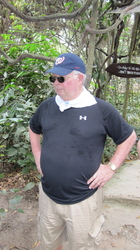
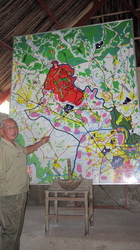
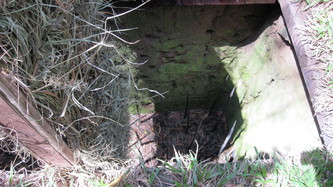
 RSS Feed
RSS Feed





